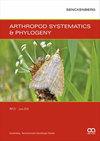Structure of the midgut epithelium in four diplopod species: histology, histochemistry and ultrastructure
IF 1.8
2区 农林科学
Q2 ENTOMOLOGY
引用次数: 4
Abstract
Abstract The middle region of the digestive system of millipedes, the midgut, is responsible for all processes connected with digestion, but also takes part in homeostasis maintenance thanks to the ability to activate many mechanisms which neutralize changes occurring at different levels of the animal’s body. Numerous millipede species are treated as bioindicators of the natural environment and they are exposed to different stressors which originate from external environment. To obtain all data on the functioning of midgut of millipedes as the barrier against stressors, it is necessary to have a precise and general description of the midgut epithelium. Members from four millipede orders were selected for the studies: Polydesmus angustus (Polydesmida), Epibolus pulchripes (Spirobolida), Unciger transsilvanicus (Julida) and Glomeris tetrasticha (Glomerida). The structure and ultrastructure of their midgut epithelial cells (the digestive, secretory and regenerative cells) were documented using transmission electron microscopy and histochemical methods. The obtained results have been compared and discussed to previous ones, to present the general and structural organization of the midgut in Diplopoda. Our studies revealed that the ultrastructure of all cells which form the midgut epithelium in millipedes is general for all the species studied up to now and it resembles the cell ultrastructure observed in Chilopoda and Hexapoda, including the digestive, secretory and stem cells.四种二足动物中肠上皮的结构:组织学、组织化学和超微结构
摘要千足虫消化系统的中间区域,即中肠,负责与消化相关的所有过程,但由于能够激活许多机制来中和动物身体不同层面发生的变化,因此也参与体内平衡的维持。许多千足虫物种被视为自然环境的生物指示剂,它们暴露于来自外部环境的不同压力源中。为了获得关于千足虫中肠作为抵抗应激源屏障的所有数据,有必要对中肠上皮进行精确和全面的描述。来自四个千足目的成员被选中进行研究:Polydesmus angustus(Polydesmida)、Epibolus pulchripes(Spirobolida)、Unchiger transsilvanicus(Julida)和Glomeris tetrasticha(Glomerida)。用透射电镜和组织化学方法记录了中肠上皮细胞(消化细胞、分泌细胞和再生细胞)的结构和超微结构。将所得结果与以前的结果进行了比较和讨论,以介绍双足目中肠的一般和结构组织。我们的研究表明,千足虫中肠上皮的所有细胞的超微结构对迄今为止研究的所有物种都是普遍的,它类似于在Chilopoda和Hexapoda中观察到的细胞超微结构,包括消化细胞、分泌细胞和干细胞。
本文章由计算机程序翻译,如有差异,请以英文原文为准。
求助全文
约1分钟内获得全文
求助全文
来源期刊

Arthropod Systematics & Phylogeny
Agricultural and Biological Sciences-Insect Science
CiteScore
2.50
自引率
5.60%
发文量
26
审稿时长
12 weeks
期刊介绍:
Arthropod Systematics & Phylogeny releases three times per year. Research fields covered are the taxonomy, morphology/anatomy, phylogeny (molecular or morphology-based), historical biogeography and palaeontology of arthropod taxa.
Arthropod Systematics & Phylogeny is the successor of Entomologische Abhandlungen, formerly published by the Museum of Zoology Dresden, Germany.
 求助内容:
求助内容: 应助结果提醒方式:
应助结果提醒方式:


